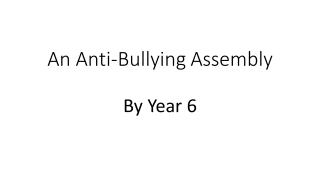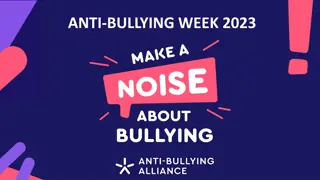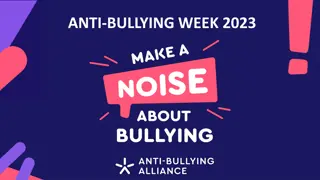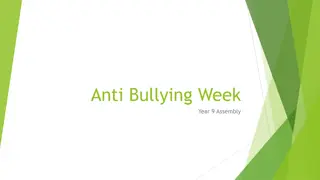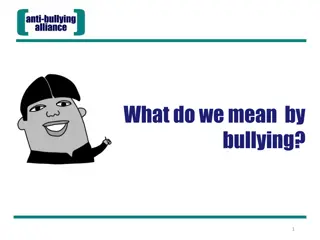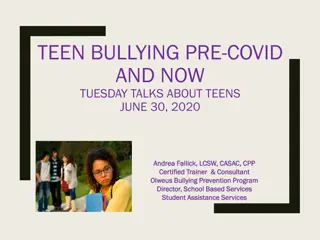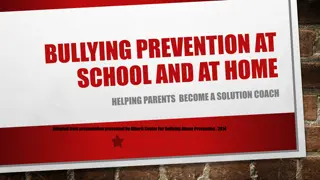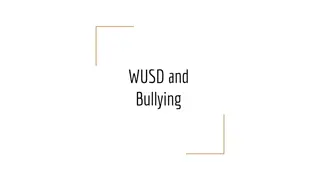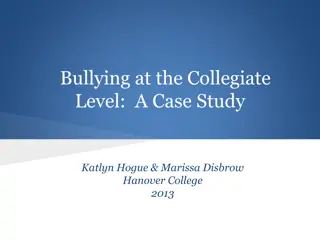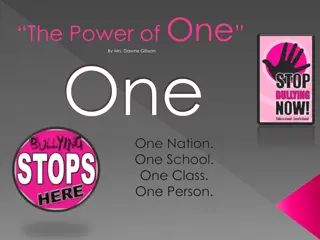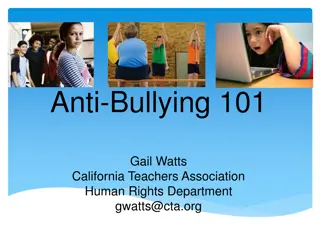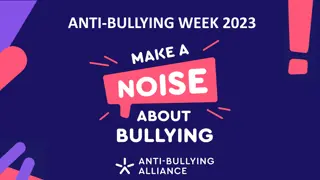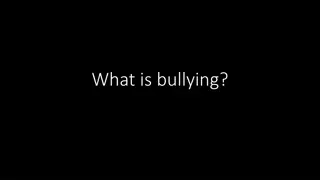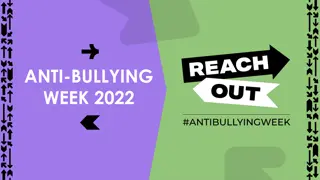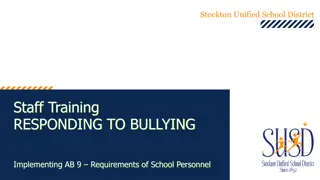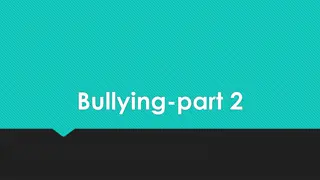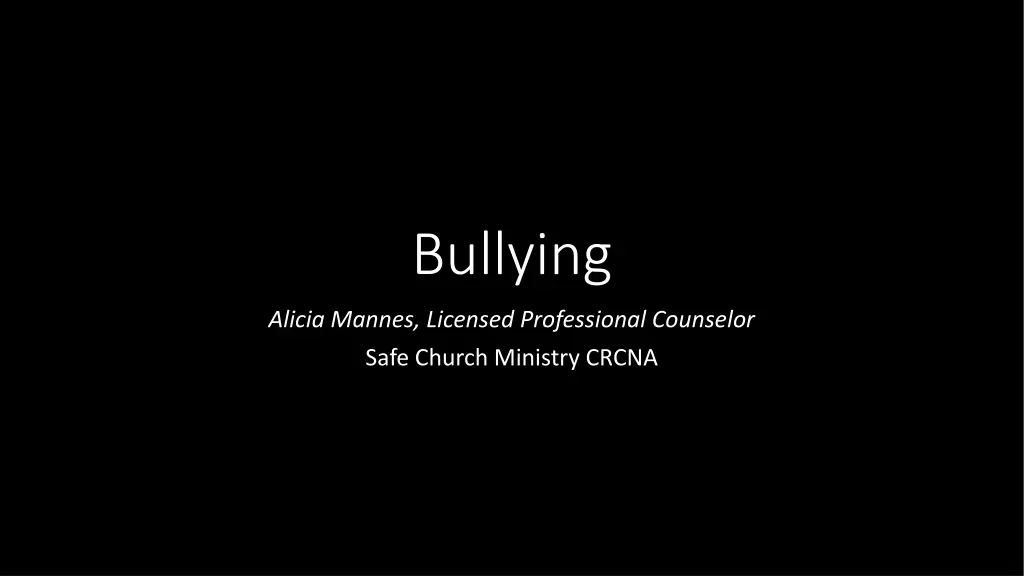
Understanding and Addressing Bullying: Signs, Types, and Prevention
Learn about the prevalence of bullying, its different types, roles children play, signs indicating a child is being bullied or bullying others, and tips on preventing and addressing bullying situations. Cyberbullying and its effects are also discussed. Take steps to create a safe environment for children and address bullying effectively.
Download Presentation

Please find below an Image/Link to download the presentation.
The content on the website is provided AS IS for your information and personal use only. It may not be sold, licensed, or shared on other websites without obtaining consent from the author. If you encounter any issues during the download, it is possible that the publisher has removed the file from their server.
You are allowed to download the files provided on this website for personal or commercial use, subject to the condition that they are used lawfully. All files are the property of their respective owners.
The content on the website is provided AS IS for your information and personal use only. It may not be sold, licensed, or shared on other websites without obtaining consent from the author.
E N D
Presentation Transcript
Bullying Alicia Mannes, Licensed Professional Counselor Safe Church Ministry CRCNA
13 Million kids will be bullied in the USA this year 1 out 4 kids are bullied 160,000 kids in the USA stay home every day due to bullying
Bullying is unwanted, aggressive behavior among school aged children that involves a real or perceived power imbalance. The behavior is repeated, or has the potential to be repeated, over time. stopbullying.gov
Bullying Types Verbal Social Physical
Roles Kids Play Kids who bully Kids who are bullied Kids who assist Kids who reinforce Bystanders Upstanders
Cyberbullying Cyberbullying is bullying that takes place using electronic technology. Electronic technology includes devices and equipment such as cell phones, computers, and tablets as well as communication tools including social media sites, text messages, chat, and websites . stopbullying.gov
Signs a Child is being Bullied Unexplainable injuries Lost or destroyed clothing, books, electronics, or jewelry Frequent headaches or stomach aches, feeling sick or faking illness Changes in eating habits, like suddenly skipping meals or binge eating. Kids may come home from school hungry because they did not eat lunch Difficulty sleeping or frequent nightmares Declining grades, loss of interest in schoolwork, or not wanting to go to school Sudden loss of friends or avoidance of social situations Feelings of helplessness or decreased self esteem Self-destructive behaviors such as running away from home, harming themselves, or talking about suicide
Signs a Child is Bullying Others Get into physical or verbal fights Have friends who bully others Are increasingly aggressive Get sent to the principal s office or to detention frequently Have unexplained extra money or new belongings Blame others for their problems Don t accept responsibility for their actions Are competitive and worry about their reputation or popularity
Why don't kids ask for help? Bullying can make a child feel helpless Kids may fear backlash from the kid who bullied them Bullying can be a humiliating experience Kids who are bullied may already feel socially isolated Kids may fear being rejected by their peers
Risk Factors Kids who are perceived as different from their peers Kids who are perceived as week or unable to defend themselves Kids who are depressed, anxious or have low self esteem Kids who are less popular than others and have few friends Kids who do not get along well with others, are seen as annoying or provoking and antagonize others for attention
Types of Bullies Well-connected to peers Isolated from peers
Contributing Factors Are aggressive or easily frustrated Have less parental involvement Have issues at home Think badly of others Have difficulty following rules View violence in positive ways Have friends who bully others
Effects of Bullying Fear Depression Loneliness Anxiety Low self esteem Physical Illness Suicidal Thoughts
Create a Safe and Supportive Environment Establish a culture of inclusion and respect that welcomes all children Make sure students interact safely Enlist the help of all staff Set a tone of openness and respect in the classroom
Stopping Bullying Intervene immediately Separate the kids involved Make sure the kids are safe Meet immediate needs Stay calm Reassure the kids involved and bystanders Model respectful behavior
Common Mistakes Don t ignore bullying Don t immediately try to sort out the facts Don t force kids to say what they saw publicly Don t question kids involved in front of other kids, talk to kids separately Don t make the kids apologize on the spot
Getting The Facts Keep all involved children separate Get the story form several sources Listen without blaming Don t call the act bullying while you are trying to understand what happened
Providing Support Listen and focus on the child Assure the child that bullying is not their fault Kids who are bullied may struggle with talking about it Give advice about what to do Work together to resolve the situation while protecting the bullied child Be persistent
Addressing Bullying Behavior Make sure the child knows what the problem is Show kids that bullying is taken seriously Work with the child to understand some of the reasons he bullied Use consequences to teach Involve the kids who bullied in making amends
Nurturing Empathy Practice positive discipline Spotlight feelings Role Play Encourage Journaling Teach about real-life people Plan Service Projects Invite kids to practice empathetic reactions Praise positive behavior Provide opportunities for fellowship and friendships
Dont Don t think it is your fault; nobody deserves to be bullied Don t fight back or bully a person back Don t say mean things back Don t keep it a secret; Tell someone! (telling is not tattling) Don t cry in front of bullies. Bullies love to have power over people. When you cry, you give them what they want. If you show them you are not sad and scared, they may lose interest
Dont Don t make threats. Bullies respond to threats with more bullying Don t ignore the bullying. Bullies want a reaction from the people they are picking on. If you ignore them, they will try harder Don t stay home. Bullies who can scare kids away, feel really powerful
Do Tell a friend, someone who will listen, support and stick up for you Tell your parents Tell your counselor. Bullies are sneaky, they do most of the their bullying where adults can t see or hear it Say: Excuse me, I have a safety problem or I really need your help Avoid areas where the bully is
What To Do Stand straight and keep head up Look the bully in the eye Have both hands up with palms out, like a fence
What To Do Say in a firm, confident voice: Leave me alone! Stop! Stop it! I don t like that! Stay calm and walk away. Don t turn back around, no matter what they say. Don t react or respond Walk toward a crowded place or a group of your friends. Bullies don t usually pick on people in a group Leave with awareness and confidence
Next Steps Find out if your church has an anti-bullying or behavior policy If not, create a Bullying Policy for Cadets Educate Counselors on this policy Educate Cadets on this policy
Resources www.stopbullying.gov www.stompoutbullying.org www.kidpower.org Focus on the Family Stick up for Yourself! Gershen Kaufman, Ph.D. www.crcna.org/SafeChurch Creating a No-Bully Zone Jolanda Howe (CRCNA Network)

